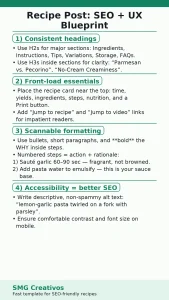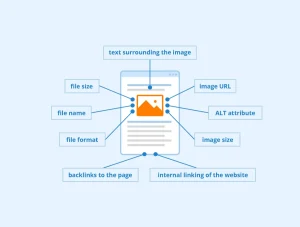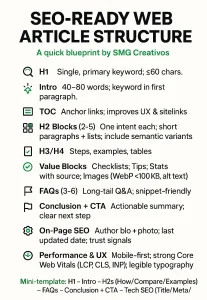Audience appetite is infinite—but attention is scarce. Food blogging succeeds when your pages load fast, your recipes are easy to use, and your expertise is obvious. This guide gives you actionable SEO moves you can implement today—no fluff, just bite-sized steps with examples.
Whether you’re sharing quick weeknight dinners or sourdough sorcery, these tips will help you build on-page clarity, strong E-E-A-T (Experience, Expertise, Authoritativeness, Trustworthiness), clean Recipe JSON-LD, smart interlinking, and lightweight images (<100 KB)—all in one coherent playbook.
H1, Titles, URLs, and Intros: Nail the First Bite
Write titles that match intent
-
Bad: “My Favorite Pasta”
-
Better: “Creamy Lemon Garlic Pasta (20 Minutes, One Pan)”
Why it works: primary keyword (lemon garlic pasta), value props (time + method), and a clear angle.
Keep slugs short and readable
-
/recipes/lemon-garlic-pasta beats /2025/10/08/blog-post-1234
Descriptive slugs help users and search engines, and play nicely when pasted into DMs.
Open with a scannable promise
Your first 1–3 sentences should name the recipe, call out key attributes (time, diet, tools), and set expectations:
This 20-minute lemon garlic pasta is creamy without heavy cream, uses one pan, and works with gluten-free spaghetti. You’ll build flavor with garlic-infused oil, then finish with starchy pasta water and lemon.
On-Page Best Practices: Structure That Serves Readers
Use consistent, helpful headings
-
H2s for major sections: Ingredients, Instructions, Tips, Variations, Storage, FAQs.
-
H3s inside sections for clarity: “Parmesan vs. Pecorino,” “No-Cream Creaminess.”
Front-load the essentials
-
Recipe card near the top with time, yields, ingredients, steps, nutrition, and a Print button.
-
Jump-to-recipe and jump-to-video links for impatient readers.
Use bullets, short paragraphs, and bold for scannability
-
Bold the “why” inside steps (e.g., Reduce heat to prevent curdling).
-
Break instructions into numbered steps with action + rationale:
-
Sauté garlic 60–90 seconds—fragrant, not browned.
-
Add pasta water to create an emulsion; this is your sauce base.
-
Accessibility and alt text
-
Descriptive, non-spammy alt text: “lemon garlic pasta twirled on a fork with parsley” (not “best pasta recipe lemon garlic EASY”).
-
Ensure contrast and font size are comfortable on mobile. Accessibility helps humans and SEO.
E-E-A-T for Food Blogs: Show the Cook, Not Just the Cookie
Experience and trust win. Search engines and readers both look for authentic, tested recipes.
What to add site-wide
-
About page with your culinary background, testing process, and editorial standards.
-
Author bios on posts with a short credential or lived experience: “Recipe tested 4 times; gluten-free variant verified.”
-
Contact page and privacy policy/affiliate disclosure—trust signals matter.
What to add in each recipe
-
Why your method works (e.g., “starchy water emulsifies fat and acid”).
-
Testing notes and pitfalls: “Sauce splits if you add lemon too early—add off heat.”
-
Sourcing details: “Use unwaxed lemons; jarred garlic tastes dull here.”
-
Variations with constraints: dairy-free, vegan, budget, high-protein.
Credibility boosters
-
Process photos you actually shot.
-
Short video showing texture cues (e.g., “sauce should coat the back of a spoon”).
-
Citations for food safety or nutrition claims (link to reliable sources, not competitors).
Recipe JSON-LD: Structured Data That Powers Rich Results
Don’t rely on plugins alone—verify output. The goal is valid, complete Recipe schema that mirrors your recipe card and matches on-page content.
Required/Recommended fields to include
-
@type,name,image,description,recipeIngredient,recipeInstructions,prepTime,cookTime,totalTime,recipeYield,author,datePublished,keywords,recipeCategory,recipeCuisine,aggregateRating,nutrition,video(when available).
Clean example (customize to your post)
{
"@context": "https://schema.org",
"@type": "Recipe",
"name": "Creamy Lemon Garlic Pasta",
"description": "A 20-minute, one-pan lemon garlic pasta with a silky, no-cream sauce.",
"image": [
"https://example.com/images/lemon-garlic-pasta.webp"
],
"author": {
"@type": "Person",
"name": "Alex Rivera"
},
"datePublished": "2025-10-08",
"prepTime": "PT5M",
"cookTime": "PT15M",
"totalTime": "PT20M",
"recipeYield": "4 servings",
"recipeCategory": "Dinner",
"recipeCuisine": "Italian",
"keywords": "lemon garlic pasta, one-pan pasta, weeknight dinner",
"recipeIngredient": [
"12 oz spaghetti",
"3 tbsp olive oil",
"4 cloves garlic, thinly sliced",
"1 lemon, zest and juice",
"1/2 cup grated Parmesan",
"1 cup reserved pasta water",
"Salt and black pepper",
"2 tbsp chopped parsley"
],
"recipeInstructions": [
{
"@type": "HowToStep",
"text": "Cook pasta in salted water until al dente. Reserve 1 cup pasta water."
},
{
"@type": "HowToStep",
"text": "Warm olive oil and garlic 60–90 seconds until fragrant; do not brown."
},
{
"@type": "HowToStep",
"text": "Add pasta water and whisk to emulsify. Toss in pasta, lemon zest, and Parmesan off heat. Season and finish with lemon juice and parsley."
}
],
"aggregateRating": {
"@type": "AggregateRating",
"ratingValue": "4.8",
"ratingCount": "128"
},
"nutrition": {
"@type": "NutritionInformation",
"calories": "420 kcal",
"carbohydrateContent": "58 g",
"proteinContent": "12 g",
"fatContent": "14 g"
}
}
Tips:
-
Ensure times match your recipe card; mismatches confuse validators.
-
If you add video, include
contentUrl,thumbnailUrl,uploadDate, anddurationusingVideoObject. -
Test with Rich Results Test and fix warnings when possible, not just errors.
- You can do it easily with GPT Chat.
Interlinking: Build Topic Hubs That Google (and Humans) Understand
Smart internal linking distributes authority, clarifies context, and keeps readers exploring.
Create “hub and spoke” structures
-
Hub pages (e.g., “30-Minute Dinners,” “Gluten-Free Baking Basics”) explain the concept and link to child recipes.
-
Each recipe links back to its hub and sideways to siblings (“Try my 15-Minute Garlic Shrimp next”).
Anchor text that helps
-
Good: “See my creamy orzo with mushrooms for another one-pot dinner.”
-
Weak: “Click here.”
Where to interlink inside a post
-
Intro: 1 internal link to a closely related, higher-authority page.
-
Ingredients/Tips: link to ingredient guides (e.g., “How to Zest a Lemon Without a Zester”).
-
Variations: link to dietary swaps or pantry explainer posts.
-
End of post: “If you liked this, you’ll love…” list of 3 recipes.
Maintain evergreen “best of” indexes
-
Keep seasonal collections (e.g., “Summer Salads”) updated quarterly and link them site-wide (footer, nav). Stable URLs accrue history and links.
Image SEO: Gorgeous, Fast, and Under 100 KB
Images sell recipes. Speed sells conversions. You need both.
Capture and choose images with purpose
-
Hero image shows the final dish clearly with appetizing color and texture.
-
Process images focus on critical steps or textures (“sauce consistency,” “peaks stage”).
File formats and sizes
-
Prefer WebP or AVIF for <100 KB hero images at ≥1200 px width when possible.
-
Keep thumbnails ~20–40 KB.
-
Avoid text baked into images; use HTML/CSS for titles and captions.
Compression workflow (simple and repeatable)
-
Export at 2× the display size from your editor.
-
Convert to WebP at ~70–80 quality (adjust until <100 KB).
-
Add width/height attributes in HTML to prevent layout shifts (helps CLS).
-
Use lazy-loading (
loading="lazy") below the fold.
Descriptive file names and alt text
-
lemon-garlic-pasta-one-pan.webp+ alt: “skillet of creamy lemon garlic pasta topped with parsley”.
Content Depth and UX: Make Posts Useful, Not Just Optimized
Include real testing insights
-
“I tried almond milk; sauce broke. Oat milk held better. Use oat if dairy-free.” That’s E-E-A-T in action.
Structured FAQs
Add FAQ content for actual reader questions you’ve seen in comments:
-
Can I use bottled lemon juice?
-
How do I keep leftovers creamy?
Avoid bloating; answer crisply and link to relevant guides.
Clear CTAs
-
“Print Recipe”, “Rate & Review”, and “Save to Collection” buttons should be visible.
-
Invite readers to leave a rating (which can feed
aggregateRatingwhen you use a compliant system).
Technical SEO Basics That Compound Over Time
Speed and Core Web Vitals
-
Avoid bloated theme bundles, too many font weights, and heavyweight analytics.
-
Defer non-critical JS; inline critical CSS for the recipe card.
-
Set caching and a CDN for images.
Canonicals and duplicates
-
Consolidate print pages with
rel="canonical"to the main recipe. -
Use canonical URLs when doing syndication or guest posts to avoid duplication confusion.
Category and tag hygiene
-
Keep categories broad (e.g., Dinner, Baking, Meal Prep) and tags precise (e.g., lemon, one-pan, gluten-free).
-
Avoid near-duplicate categories that compete with each other.
Editorial Calendar: Hit Intents Across the Funnel
Top-of-funnel (discovery)
-
“How to Stock a Mediterranean Pantry” → interlinks to 5 Mediterranean recipes.
Mid-funnel (decision)
-
“30-Minute Dinners for Busy Weeknights” → interlinks to your fastest mains.
Bottom-funnel (action)
-
“Meal Prep Lemon Garlic Pasta (4 Servings, $1.50/Serving)” → speaks to budget, quantity, and storage; primes for conversion (print, subscribe, share).
Consistency compounds. Publish on a cadence you can sustain—weekly beats sporadic sprints.
Example: Putting It All Together (Mini Template)
Title (H1): Creamy Lemon Garlic Pasta (20 Minutes, One Pan)
Intro: 2–3 sentences with value props and dietary notes
Recipe card: near the top (times, yield, ingredients, steps, nutrition)
H2 Ingredients: bullets + brand/measure clarifications
H2 Instructions: numbered steps with bolded cues
H2 Tips & Troubleshooting: why sauces split; how to fix
H2 Variations: dairy-free, protein add-ins, gluten-free
H2 Storage & Reheat: exact times/temps, texture tips
H2 FAQs: real reader questions
H2 Serving Ideas: internal links to sides/salads
H2 More Quick Dinners: 3 internal links (anchor text descriptive)
JSON-LD: validated, matching recipe card
Images: WebP <100 KB, descriptive alt, lazy-load
Take this picture with you so you don’t forget it:
Promotion and Feedback Loops
Social snippets that reinforce SEO
-
Share a process clip on Reels/Shorts and link to the post.
Capture ratings and comments
-
Ratings drive engagement and trust; remind readers at the end and via inline prompts (“Tried it? Tap ★★★★★ to rate!”).
Update winners
-
When a post takes off, improve it: tighter intro, add a video, clarify steps readers tripped on, refresh images, and republish with the same URL.
Common Pitfalls (and Quick Fixes)
-
Walls of text before the recipe card. Fix: Jump-to-recipe, plus a short intro.
-
Plugin-generated schema that doesn’t match the card. Fix: Audit fields after publishing.
-
Heavy JPEGs (300–500 KB). Fix: Convert to WebP, cap at <100 KB.
-
Thin category pages. Fix: add intro copy (40–80 words) and featured posts.
-
Random interlinks. Fix: plan hub pages and intent-based anchors.
Content Refresh Checklist (Quarterly)
-
Re-test popular recipes: confirm times, temperatures, and tips.
-
Re-shoot one hero image if it’s dark/dated.
-
Re-validate Recipe JSON-LD for top 20 posts.
-
Add FAQs based on comments and emails.
-
Re-compress images and purge CDN cache.
-
Update seasonal collections and front-page features.
The Mindset That Wins
Food SEO is not about tricking an algorithm; it’s about removing friction between a hungry reader and a successful cook-through. Give people clear steps, visual cues, speedy pages, and the confidence of a well-tested recipe. The rest—rankings, traffic, loyal fans—tends to follow.
From Click to Cook—Make It Effortless
When in doubt, simplify. Lead with a clear recipe card, validate your Recipe JSON-LD, link readers to genuinely helpful related posts, and keep your images crisp and under 100 KB. Pair that with authentic testing notes and a friendly voice, and you’ll build a blog that’s both search-friendly and cook-approved.









